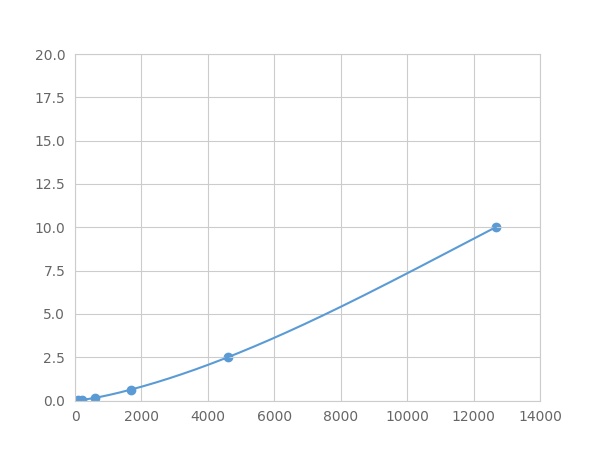Packages (Simulation)

Reagent Preparation

Image (I)
Image (II)
Certificate


Multiplex Assay Kit for Tissue Plasminogen Activator (tPA) ,etc. by FLIA (Flow Luminescence Immunoassay)
PLAT; T-PA; t-plasminogen activator; Alteplase; Reteplase
(Note: Up to 8-plex in one testing reaction)
- Product No.LMA525Mu
- Organism SpeciesMus musculus (Mouse) Same name, Different species.
- Sample Typeserum, plasma and other biological fluids
- Test MethodDouble-antibody Sandwich
- Assay Length3.5h
- Detection Range0.01-10ng/mL
- SensitivityThe minimum detectable dose of this kit is typically less than 0.003 ng/mL.
- DownloadInstruction Manual
- UOM 8Plex 7Plex 6Plex 5Plex 4Plex 3Plex 2Plex1Plex
- FOB
US$ 405
US$ 420
US$ 443
US$ 475
US$ 506
US$ 552
US$ 622
US$ 778
Add to Price Calculator
Result
For more details, please contact local distributors!
Specificity
This assay has high sensitivity and excellent specificity for detection of Tissue Plasminogen Activator (tPA) ,etc. by FLIA (Flow Luminescence Immunoassay).
No significant cross-reactivity or interference between Tissue Plasminogen Activator (tPA) ,etc. by FLIA (Flow Luminescence Immunoassay) and analogues was observed.
Recovery
Matrices listed below were spiked with certain level of recombinant Tissue Plasminogen Activator (tPA) ,etc. by FLIA (Flow Luminescence Immunoassay) and the recovery rates were calculated by comparing the measured value to the expected amount of Tissue Plasminogen Activator (tPA) ,etc. by FLIA (Flow Luminescence Immunoassay) in samples.
| Matrix | Recovery range (%) | Average(%) |
| serum(n=5) | 98-105 | 102 |
| EDTA plasma(n=5) | 86-104 | 91 |
| heparin plasma(n=5) | 78-99 | 84 |
Precision
Intra-assay Precision (Precision within an assay): 3 samples with low, middle and high level Tissue Plasminogen Activator (tPA) ,etc. by FLIA (Flow Luminescence Immunoassay) were tested 20 times on one plate, respectively.
Inter-assay Precision (Precision between assays): 3 samples with low, middle and high level Tissue Plasminogen Activator (tPA) ,etc. by FLIA (Flow Luminescence Immunoassay) were tested on 3 different plates, 8 replicates in each plate.
CV(%) = SD/meanX100
Intra-Assay: CV<10%
Inter-Assay: CV<12%
Linearity
The linearity of the kit was assayed by testing samples spiked with appropriate concentration of Tissue Plasminogen Activator (tPA) ,etc. by FLIA (Flow Luminescence Immunoassay) and their serial dilutions. The results were demonstrated by the percentage of calculated concentration to the expected.
| Sample | 1:2 | 1:4 | 1:8 | 1:16 |
| serum(n=5) | 96-103% | 90-104% | 85-92% | 93-101% |
| EDTA plasma(n=5) | 86-101% | 99-105% | 78-99% | 90-105% |
| heparin plasma(n=5) | 95-102% | 86-94% | 85-94% | 98-105% |
Stability
The stability of kit is determined by the loss rate of activity. The loss rate of this kit is less than 5% within the expiration date under appropriate storage condition.
To minimize extra influence on the performance, operation procedures and lab conditions, especially room temperature, air humidity, incubator temperature should be strictly controlled. It is also strongly suggested that the whole assay is performed by the same operator from the beginning to the end.
Reagents and materials provided
| Reagents | Quantity | Reagents | Quantity |
| 96-well plate | 1 | Plate sealer for 96 wells | 4 |
| Pre-Mixed Standard | 2 | Standard Diluent | 1×20mL |
| Pre-Mixed Magnetic beads (22#:tPA) | 1 | Analysis buffer | 1×20mL |
| Pre-Mixed Detection Reagent A | 1×120μL | Assay Diluent A | 1×12mL |
| Detection Reagent B (PE-SA) | 1×120μL | Assay Diluent B | 1×12mL |
| Sheath Fluid | 1×10mL | Wash Buffer (30 × concentrate) | 1×20mL |
| Instruction manual | 1 |
Assay procedure summary
1. Preparation of standards, reagents and samples before the experiment;
2. Add 100μL standard or sample to each well,
add 10μL magnetic beads, and incubate 90min at 37°C on shaker;
3. Remove liquid on magnetic frame, add 100μL prepared Detection Reagent A. Incubate 60min at 37°C on shaker;
4. Wash plate on magnetic frame for three times;
5. Add 100μL prepared Detection Reagent B, and incubate 30 min at 37°C on shaker;
6. Wash plate on magnetic frame for three times;
7. Add 100μL sheath solution, swirl for 2 minutes, read on the machine.
GIVEAWAYS
INCREMENT SERVICES
| Magazine | Citations |
| Annals of Clinical & Laboratory Science | Alteration of Hemostatic Parameters in Patients with Different Levels of Subclinical Hypothyroidism and the Effect of L-thyroxine Treatment pubmed:28249913 |
| Cellular Physiology and Biochemistry | Defective Platelet Activation and Bleeding Complications upon Cholestasis in Mice pubmed:28441661 |
| Journal of allergy and clinical immunology | Cytokine and estrogen stimulation of endothelial cells augments activation of the prekallikrein-high molecular weight kininogen complex: Implications for hereditary angioedema. pubmed:27826093 |
| European Journal of Neuroscience | Urokinase receptor and tissue plasminogen activator as immediate‐early genes in pentylenetetrazole‐induced seizures in the mouse brain Pubmed: 31587391 |
| Phytomedicine | Sodium aescinate significantly suppress postoperative peritoneal adhesion by inhibiting the RhoA/ROCK signaling pathway Pubmed: 32120245 |
| Sci Rep | Fibroblast growth factor-21 as a novel metabolic factor for regulating thrombotic homeostasis Pubmed:35013379 |
| Catalog No. | Related products for research use of Mus musculus (Mouse) Organism species | Applications (RESEARCH USE ONLY!) |
| APA525Mu01 | Active Tissue Plasminogen Activator (tPA) | Cell culture; Activity Assays. |
| RPA525Mu02 | Recombinant Tissue Plasminogen Activator (tPA) | Positive Control; Immunogen; SDS-PAGE; WB. |
| RPA525Mu01 | Recombinant Tissue Plasminogen Activator (tPA) | Positive Control; Immunogen; SDS-PAGE; WB. |
| PAA525Mu01 | Polyclonal Antibody to Tissue Plasminogen Activator (tPA) | WB; IHC; ICC; IP. |
| PAA525Mu02 | Polyclonal Antibody to Tissue Plasminogen Activator (tPA) | WB; IHC; ICC; IP. |
| LAA525Mu71 | Biotin-Linked Polyclonal Antibody to Tissue Plasminogen Activator (tPA) | WB; IHC; ICC. |
| SEA525Mu | ELISA Kit for Tissue Plasminogen Activator (tPA) | Enzyme-linked immunosorbent assay for Antigen Detection. |
| SCA525Mu | CLIA Kit for Tissue Plasminogen Activator (tPA) | Chemiluminescent immunoassay for Antigen Detection. |
| LMA525Mu | Multiplex Assay Kit for Tissue Plasminogen Activator (tPA) ,etc. by FLIA (Flow Luminescence Immunoassay) | FLIA Kit for Antigen Detection. |





